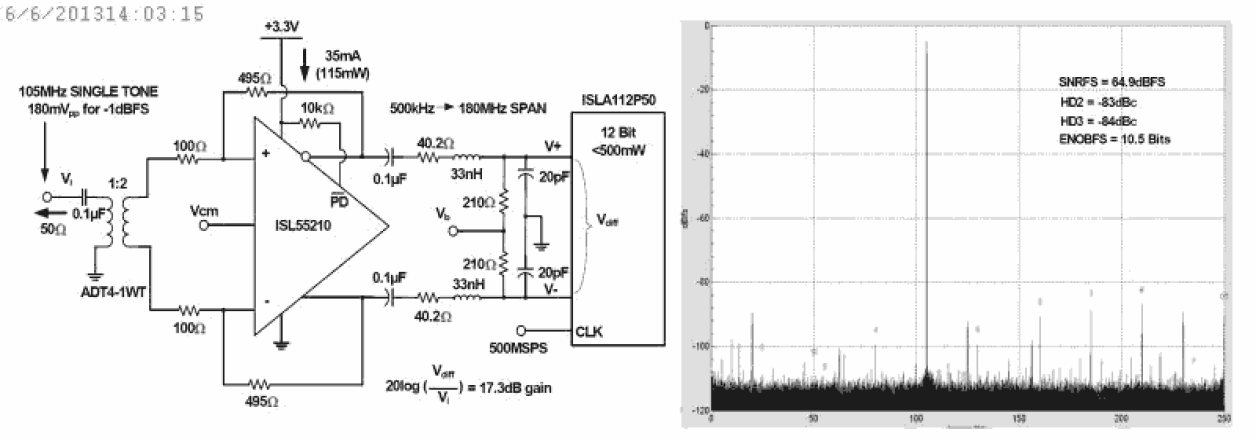特性
- Gain bandwidth product: 4.0GHz
- Input voltage noise: 0.85nV/√(Hz)
- Differential slew rate: 5,600V/µs
- 2VP-P, 2-tone IM3 (200Ω) 100MHz: -109dBc
- Supply voltage range: 3.0V to 4.2V
- Quiescent power (3.3V supply): 115mW
描述
The ISL55210 is a very wide band, fully differential amplifier (FDA) intended for high dynamic range ADC input interface applications. This voltage feedback FDA design includes an independent output common mode voltage control. At the lowest quiescent power (115mW), the ISL55210 offers a 4.0GHz gain bandwidth product with a very low input noise of 0.85nV/√(Hz). In a balanced differential I/O configuration, with 2VP-P output into a 200Ω load configured for a gain of 15dB, the IM3 terms are <-100dBc through 110MHz. With a minimum operating gain of 2V/V (6dB), the ISL55210 supports a wide range of higher gains with minimal BW or SFDR degradation. Its ultra-high differential slew rate of 5,600V/µs ensures clean large signal SFDR performance or a fast settling step response. The ISL55210 requires only a single 3.3V (max 4.2V) power supply with a 35mA typical quiescent current. This industry-leading low-current solution can be further reduced when needed using the optional power shutdown to <0.4mA supply current. External feedback and gain setting resistors give maximum flexibility and accuracy. A companion device, the ISL55211, includes on-chip feedback and three possible gain setting connections where an internally fixed gain solution is preferred. The ISL55210 is available in a leadless, 16 Ld TQFN package and is specified for operation over the -40 °C to +85 °C ambient temperature range.
产品参数
| 属性 | 值 |
|---|---|
| Channels (#) | 1 |
| Temp. Range (°C) | -40 to +85°C |
| Bandwidth (MHz) | 2200 |
| Gain Min | 2 |
| Offset Voltage (Max) (mV) | 1.4 |
| IBIAS (nA) | 50000 |
| IOUT (A) | 0.045 |
| CMRR (dB) | 75 |
| PSRR (db) | 90 |
| Rail-to-Rail Input | No |
| Rail-to-Rail Output | No |
| IS per Amp (mA) | 35 |
| Noise VN (nV/√Hz) | 0.85 |
| Single Supply Voltage Range (V) | 3 - 4.2 |
| Slew Rate (V/µs) | 5600 |
| VOUT (V) | 3.8 |
| VS (Min) (V) | 3 |
| VS (Max) (V) | 4.2 |
| 2nd Harmonic (dB) | -105 |
| 3rd Harmonic (dB) | -120 |
| AVOL (dB) | 100 |
| Topology [Rail 1] | FDA |
| Enable | Yes |
| Output Headroom (V) | 1 |
| Distortion Conditions | 2Vpp, 20MHz |
| Qualification Level | Standard |
封装选项
| Pkg. Type | Pkg. Dimensions (mm) | Lead Count (#) | Pitch (mm) |
|---|---|---|---|
| TQFN | 3.0 x 3.0 x 0.75 | 16 | 0.5 |
应用
- Low power, high dynamic range ADC interfaces
- Differential mixer output amplifiers
- SAW filter pre/post driver
- Differential Comms-DAC output drivers
当前筛选条件
筛选
软件与工具
样例程序
模拟模型
This video demonstrates some wideband single ended input to differential output options using the ISL55210 Active Balun Evaluation Platform.
This video demonstrates other ways of doing the signal to differential using an FDA with the ISL55210 Active Balun Evaluation Platform.
This video discusses the ISL55210 Active Balun Evaluation Platform's test results for frequency response and measured noise.
The demo concludes for the ISL55210 Active Balun Evaluation Platform and discusses input impedance match.
The high-speed ADC evaluation platform enables rapid testing and performance validation of the entire portfolio of low-power 8 to 16-bit, 40 to 500MSPS high-performance analog-to-digital converters.
Resources
This video demonstrates the platform daughter board that includes both an ISL55210 FDA and an ISLA112P50 12-bit, 500 MSPS ADC.
This video walks you through the proper set up of your own data acquisition test environment, from the initial signal generator all the way through the data acquisition motherboard. You'll need the daughterboard with the ISL55210 FDA as well as the ISLA112P50 12-bit, 500 MSPS ADC.
Resources
This video demonstrates the industry-leading performance you can expect with the ISL55210 FDA and ISLA112P50 ADC, and shows you how to use the proprietary data acquisition evaluation software.

